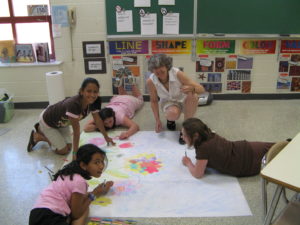A couple of my students from Spring ‘09 Color Theory told me that they loved the experience of community in their art classes. This interests me. To them, the chance to work together or along side each other with some tricky projects, to discuss and critique in developing relationships over time was a neat part of their growing college experience, and highly valued. I come from such a different time than these kids. When I was in college independent thinking and solo learning was expected. To come up with conclusions as a group would have been considered somewhat suspect, sloppy, or at least auxiliary to the more important solo work. It was every man/woman for himself (as if individuals on their own have all potential access to higher learning). I am changing my mind as I watch what happens when students get engaged and start problem solving together. There is a dynamic there in a group that seems larger than the sum of the parts; that is an exciting synthesis of possible outcomes in newer ways, and students emerge having caught things the teacher does not even yet know. I did have an unusual bunch of great kids this past term, I even thought several times, “maybe I should quit while I’m ahead”, for it is a lot of work anticipating and then evaluating with this kind of discovery approach to keep it still on track. But forged relationships move beyond the classroom and into life. This really interests me.
Continued Leaning in Community
I tried the same group approach to problem solving with some of my after school kids in a local Elementary School. We had 45 minutes to make a mural that showed what the group wanted to communicate. They swang into action, and what was fascinating to me was how they synthesized content quickly, coming to their own ideas and moved into tasks. Leaders emerged, specialists took their part and started to shine, helpers got joy in being necessary, and everybody had fun. Time stopped here, and we ended up with something that was the fruit of collaborative work that can never again be repeated. I expect the lessons learned there were more than just mural coloring.

I am also involved this summer with some adult learners, who are practicing ways to be better facilitators. It is the same thing I’ve been seeing happen with the college students and the grade schoolers. Get them involved, get them dialoging, get them trying and testing, and making mistakes and then evaluating. We can do this because we have a certain freedom to explore, AND a confident expectation that discovery is possible in a world where natural things can progress. It seems the very best learning happens this way. And as a teacher, I can facilitate this best when I am confident that the material can be tested and pushed this way and that, and still the authoritative kernels will sift out and show up, now all the better apprehended. This is an adventure of confident hope.
